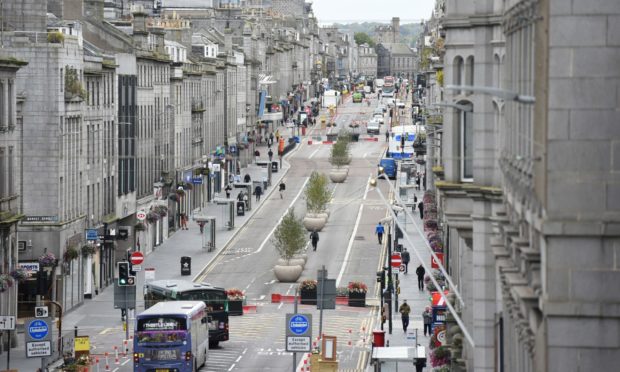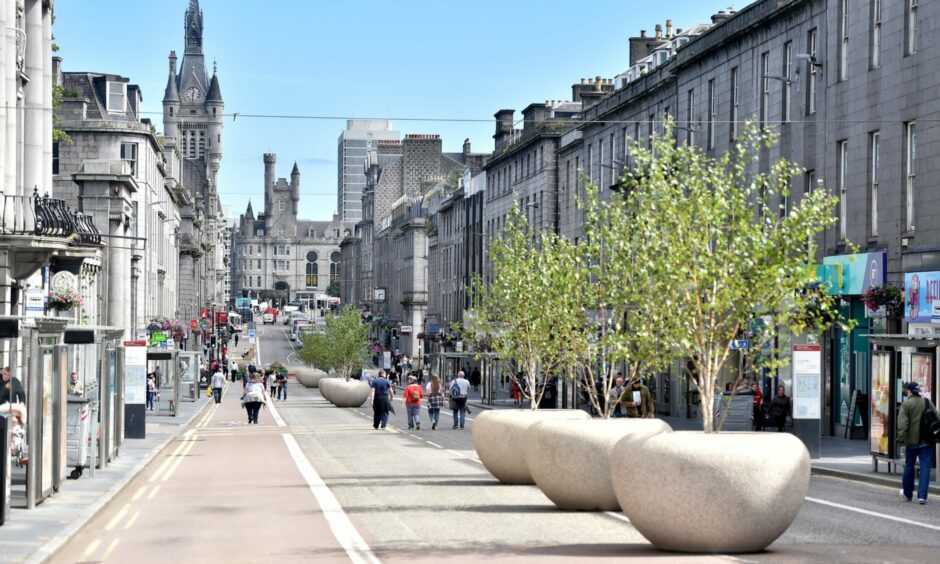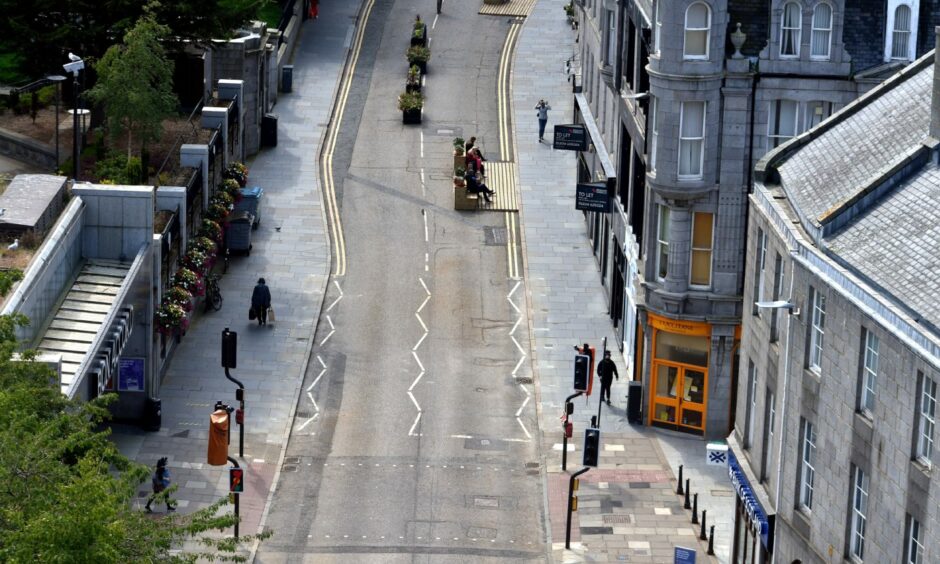Controversial road changes in Aberdeen’s city centre and the West End could remain in place until a plan for a permanent overhaul is drawn up.
Town House chiefs are arguing for the continuation of the physical distancing measures as the map out huge change in the city – and while the city lags behind the rest of the country on Covid vaccinations.
Pedestrianisation, one-way systems, bike lanes and pavement narrowing was rolled out at haste as the scale of the coronavirus emergency became apparent last year.
The Spaces For People physical distancing project was afforded leeway from the usual public consultation needed for significant roads changes as they were said to be temporary.
Health bosses backed the scheme as a way of creating more room for safe distancing in the pandemic – especially in the early days when large queues were more frequent outside shops.
The investment was also hoped to encourage more walking and cycling, with the introduction of some bike lanes.
Aberdeen City Council gained a Scottish Government £1.76 million grant to fund the work, which is currently being undone in some neighbourhoods.
George Street is already back to normal, with Rosemount and Torry soon to follow.
But it has now been confirmed the partial closure of Union Street, as well as interventions around Belmont Street, Schoolhill, Upperkirkgate and the West End could remain in place for months to come.
Widespread change planned for city centre – with Union Street overhaul to come first
We yesterday revealed design work to make permanent the pedestrianisation of the Granite Mile between Market Street and Bridge Street could be ‘prioritised’ in the roads shakeup, with the aim to bring life back to the city centre.
Council bosses believe the stretch being closed to all traffic, except perhaps buses, will improve access to the refurbished Union Terrace Gardens when it opens, as well the potential new market development on the former British Home Stores site.
Political backing could be given for detailed work to start on the designs, which are as yet without a price tag or a timeline, next week.
At that same meeting, councillors are recommended to vote to keep the Union Street, ‘Belmont Zone’ – last year referred to by traders as Checkpoint Belmont in reference to the Iron Curtain – and the West End road changes in place until plans are drawn up.
Ambitions of overhauling the city, both for economic gain and to meet environmental targets, has led to a warning removal would only lead to further costly disruption further down the line.
There is no indication of how long the design element of the far-reaching transformation project might take.
Councillors are being asked to give officials until November to come back with an update.
Resources director Steve Whyte said: “The measures currently in place were only ever temporary and this was made explicitly clear from the outset.
“However, to undertake wholesale removal at this point only to reintroduce closures as part of the city centre masterplan project would be counterproductive to the transport network, to public health, as we continue to fight Covid, and to the businesses in the city that still rely on them to remain operating.”
Aberdeen trailing Grampian and Scotland vaccination rates helps case for continued closure
While his report was written late last month, he highlighted Aberdeen trailed the wider Grampian area and Scotland in getting Covid jabs in residents’ arms.
As of August 18, 82.8% of Aberdonians had taken their first vaccine dose, and 70% had taken their second.
In Grampian the rates were 89.3% and 79.1% respectively, while nationally Public Health Scotland reported 90.8% and 78.9% had been dosed.
“This lower uptake remains worrying given the importance
that is being placed on vaccination in terms of lifting restrictions,” Mr Whyte added.
An area we call the ‘Belmont Zone’: Plans to be drawn up for city centre and West End
Early sketches have been published by the council, along with the transformative vision of Union Street, for tree-lined streets around the city.
Documents which will inform decisions to be made on a £150 million refresh of the city centre masterplan, which also includes the potential for a new football stadium as part of investment at the beach.
Changes planned for Schoolhill and Upperkirkgate could include reclaiming road space permanently for more frequent street activities.
The historic stretch is currently closed off to traffic as part of the Spaces For People project, though is regularly shut due to events such as the city’s Christmas village.
Last year, a number of traders – including family-run food hall Haigs – made plans to leave the area due to constant disruption.
But council planners say they are reviewing the area, with work to complete a comprehensive design, including widened footways, for the Schoolhill area in the pipeline.
This would stretch from the recently upgraded surface outside the art gallery to the end of Upperkirkgate at Broad Street – and tie in with hopes of creating an outdoor cafe culture taking off in Belmont Street, Back Wynd and outside the art gallery.
Meanwhile in the West End, streets currently subjected to one-way restrictions look likely to be permanently changed too.
Council documents reveal the ambition there is “an appropriate balance” of pedestrian space and traffic.
Cables of lighting, perhaps similar to Ashton Lane in Glasgow’s West End, could be wound above Rose Street, Thistle Street and Chapel Street – with planters and trees used to create new spaces for businesses to spill out onto the street.
In these streets, service access, drop off and pick up areas would be maintained to assist trade in the area – perhaps similar to what is currently, temporarily, in place.
Promise of fuller consultation after trader outrage at Spaces For People rollout
While Spaces For People was rolled out with little formal consultation in the beginning, council bosses are promising more – should members sign off on design work being undertaken on Wednesday.
It follows an initial consultation on the refresh of the city centre masterplan, which had nearly 7,700 responses.
Resources director Steve Whyte said: “Following the encouraging response from the public consultation simulator, and pending agreement of the recommendations, it is essential that key stakeholder engagement is carried out as design proposals are developed.
“An extensive stakeholder engagement plan is currently under development and will include, but not be limited to stakeholders identified in the report.”
Those groups include the community councils, civic forum, Disability Equity Partnership, transport operators, local traders and schools.
Business groups such as the Chamber Of Commerce, Aberdeen Inspired, the hotels association and hospitality trade body will also be consulted.


